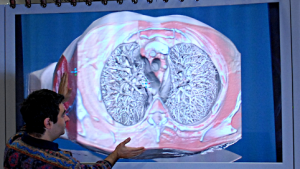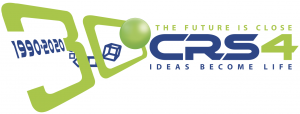CRS4 was among the first research centers to develop efficient visual computing methods and techniques to exploit the potential of new multi-projector light-field displays capable of creating virtual holograms in real-time.
Meeting the performance constraints required by these systems is a challenging task, since they require the generation of hundreds of specially distorted renderings for each light-field frame. For these purposes, we have created and developed specialized user interfaces, calibration methods, and surface and volumetric rendering techniques for both single processor and distributed parallel rendering.
Our results have been the subject of several publications and demonstrations (for example, at the SIGGRAPH 2006 Emerging Technologies event in Boston).
The research carried out on this topic was described in many publications. In particular, the display design was described in this publication:
- Tibor Balogh, Tamas Forgacs, Olivier Balet, Eric Bouvier, Fabio Bettio, Enrico Gobbetti, and Gianluigi Zanetti. A Scalable Holographic Display for Interactive Graphics Applications. In Proc. IEEE VR 2005 Workshop on Emerging Display Technologies, 2005
Innovative solutions for massive surface and volume rendering and
interaction on the displays were described in the following articles:
- Fabio Bettio, Enrico Gobbetti, Fabio Marton, and Giovanni Pintore. Scalable Rendering of Massive Triangle Meshes on Light Field Displays. Computers & Graphics, 32(1): 55-64, February 2008.
- Marco Agus, Enrico Gobbetti, José Antonio Iglesias Guitián, Fabio Marton, and Giovanni Pintore. GPU Accelerated Direct Volume Rendering on an Interactive Light Field Display. Computer Graphics Forum, 27(3): 231-240, 2008.
- José Antonio Iglesias Guitián, Enrico Gobbetti, and Fabio Marton. View-dependent Exploration of Massive Volumetric Models on Large Scale Light Field Displays. The Visual Computer, 26(6--8): 1037-1047, 2010.
- Fabio Marton, Marco Agus, Enrico Gobbetti, Giovanni Pintore, and Marcos Balsa Rodriguez. Natural exploration of 3D massive models on large-scale light field displays using the FOX proximal navigation technique. Computers & Graphics, 36(8): 893-903, December 2012.
In the following years, many other solutions followed.




